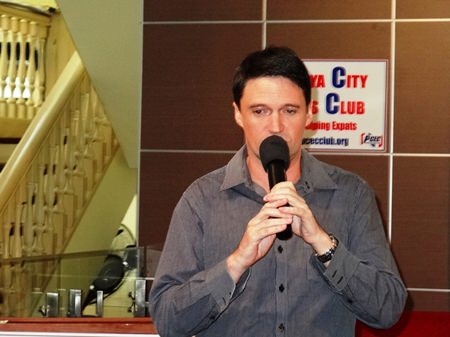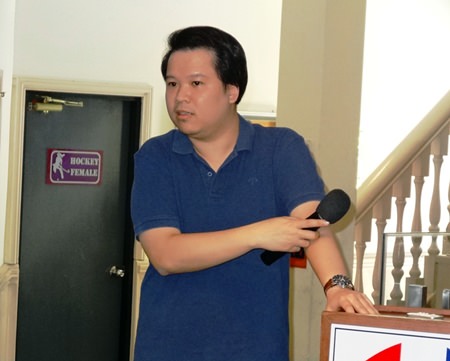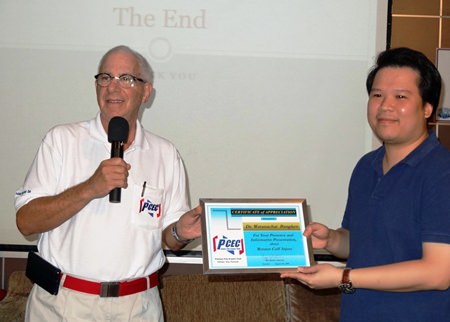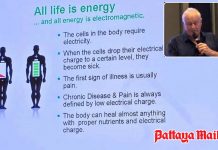This may not be what you wanted to hear, but as you get older, your risk of a painful rotator cuff injury increases. The rotator cuff is a group of muscles and tendons that attach to the bones of the shoulder joint, allowing the shoulder to move and keeping it stable.
Dr. Watanachai Bangken, an orthopaedist at Phyathai Sriracha Hospital, spoke to the Pattaya City Expats Club at their Sunday, August 24 meeting. His topic was about the kinds and symptoms of rotator cuff injury, the tools used to diagnose the injury and the options available for treatment. In introducing Dr. Watanachai, Gavin Waddell, International Marketing Executive for the Hospital, also announced that a nurse was available to provide free blood pressure check and blood sugar test for those that wanted them.
 Gavin Waddell, International Marketing Executive, Phyathai Sriracha Hospital, introduces Dr. Watanachai Bangken at the PCEC’s Sunday meeting.
Gavin Waddell, International Marketing Executive, Phyathai Sriracha Hospital, introduces Dr. Watanachai Bangken at the PCEC’s Sunday meeting.
There are two kinds of rotator cuff injury: acute and chronic. Dr. Watanachai explained that a sudden or acute tear may happen when you fall on your arm while it is stretched out, or when you engage in a sudden, jerking motion while trying to lift something heavy.
A chronic tear of the rotator cuff tendon happens slowly over time. It is more likely to occur in people with chronic tendonitis or impingement syndrome. The latter, sometimes known as “swimmer’s shoulder,” is when the tendons of the rotator cuff muscles become irritated and inflamed. Further, Dr. Watanachai said that repetitive stress is a common cause of chronic rotator cuff tears, particularly among professional athletes.
Additionally, rotator cuff tears can be partial or complete. In a partial tear, the attachments to the bone are not completely severed. A complete tear splits the soft tissue into two pieces – there is basically a hole in the tendon.
 Dr. Watanachai explains the symptoms, diagnosis, and treatment of rotator cuff injuries. The rotator cuff is a group of muscles and tendons that attach to the bones of the shoulder joint.
Dr. Watanachai explains the symptoms, diagnosis, and treatment of rotator cuff injuries. The rotator cuff is a group of muscles and tendons that attach to the bones of the shoulder joint.
Symptoms of an acute tear include intense pain after a fall or injury; and weakness of the shoulder and arm, possibly accompanied by a snapping sensation of movement. Symptoms of a chronic tear are gradual worsening of pain, weakness, and stiffness or loss of motion in the shoulder. Dr. Watanachai said that most people with rotator cuff tendon tears have pain at night; that pain may wake one up. During the day, the pain is usually more tolerable and is felt with certain arm and shoulder movements.
To diagnose rotator cuff injury, the first imaging tests performed are usually X-rays. However, because X-rays do not show the soft tissues of your shoulder (like the rotator cuff), they may not show anything amiss or they may show only a small bone spur. Dr. Watanachai said that the diagnostic tool of choice these days is MRIs. They can show where the tear is located within the tendon and the size of the tear. An MRI can also give the doctor a better idea of how “old” or “new” a tear is because it can show the quality of the rotator cuff muscles.
He explained that the goal of all treatment for rotator cuff injuries is to reduce pain and restore function. If you have a rotator cuff tear and you keep using your rotator cuff despite increasing pain, you may cause further damage. A rotator cuff tear can get larger over time.
 MC Richard Silverberg gives Dr. Watanachai a Certificate of Appreciation on behalf of the PCEC for his informative talk about rotator cuff injuries.
MC Richard Silverberg gives Dr. Watanachai a Certificate of Appreciation on behalf of the PCEC for his informative talk about rotator cuff injuries.
If you have chronic shoulder and arm pain, these are good reasons to see a doctor. Dr. Watanachai explained that early treatment can prevent your symptoms from getting worse. It will also get your shoulder back to normal that much quicker.
In about 50% of patients, non-surgical treatment relieves pain and improves function in the shoulder. Non-surgical treatment options include: rest – limiting overhead activities; and using a sling to help protect your shoulder and keep it still; non-steroidal anti-inflammatory medication – drugs like ibuprofen and naproxen reduce pain and swelling; strengthening exercises and physical therapy – to restore movement and strengthen the muscles that support your shoulder; and steroid injection – cortisone is a very effective anti-inflammatory medicine.
Dr. Watanachai emphasised that shoulder strength, however, does not usually improve without surgery. How do you know if you are a candidate for surgery? Surgery may be a good option if: your pain does not improve with non-surgical treatment; your symptoms have lasted 6-12 months; you have a large tear (more than 3 cm); you have significant weakness and loss of function in your shoulder; or your tear was caused by a recent, acute injury.
There are two kinds of surgical treatment, Dr. Watanachai explained: open repair and all-arthroscopic repair. A traditional open surgical incision is often required if the tear is large or complex (open repair). In an all-arthroscopic repair, the surgeon inserts a small camera, called an arthroscope, into your shoulder joint, and makes another small incision to perform the operation.
For people who undergo surgery, rehabilitation plays a vital role in getting them back to normal. Rehabilitation usually includes: immobilization – most likely involving the use of a sling and avoiding using one’s arm for the first 4-6 weeks; passive exercise – begun within the first 6-8 weeks after surgery; and active exercise – which involves gradually increasing one’s strength and improving one’s arm control at 8-12 weeks post-surgery.
After Dr. Watanachai concluded his presentation, Master of Ceremonies Richard Silverberg brought everyone up to date on upcoming events and called on Roy Albiston to conduct the always informative Open Forum where questions are asked and answered about Expat living in Thailand, especially Pattaya.
For more information on the PCEC’s many activities, visit their website at www.pcecclub.org.




